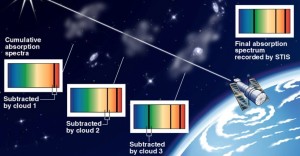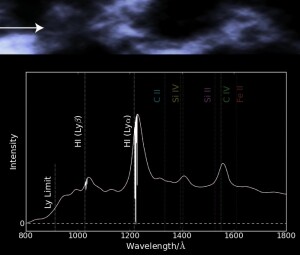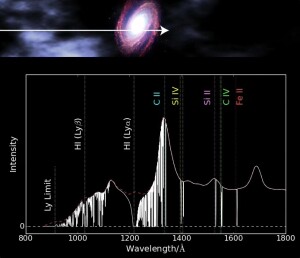“If a Picture is worth a thousand words, a Spectrum is worth a thousand Pictures!”
astronomical sage
My PhD thesis research was on spectroscopy of the interstellar medium, and used telescopes in Chile and Arizona to detect absorption lines from molecular clouds at the outskirts of our Milky Way galaxy. These molecular clouds were an interesting astrophysical phenomenon, as their origins may have been from shocked gas either falling into the Milky Way or ejected from the disk of the galaxy from supernova explosions. Their nearby location and thin optical depth also allowed them to be studied in unprecedented detail, and to elucidate some of the radiative and chemical properties inside molecular clouds that are important for star formation. After graduate school, I continued to conduct spectroscopic research on the interstellar medium using both ground-based and space telescopes such as the Hubble Space telescope. These works continued to explore nearby molecular clouds and provided helpful constraints on astrophysics of the interstellar medium.
During a sabbatical in 2004-2005, I began working on the astrophysics of absorption lines in the intergalactic medium, as detected in quasars (QSO’s) and gamma ray bursts (GRB’s). This work was in conjunction with Shri Kulkarni’s GRB group and with Wallace Sargent’s group on quasars and the “Damped Lyman Alpha” absorption systems. I was delighted to begin this chapter of my research and work with top astrophysics minds in Pasadena and to use the Keck telescope and other telescopes to unlock the evolution of element formation in the early universe and the clouds of gas surrounding galaxies revealed by Gamma Ray Bursts. You can find many of these publications in the astrophysical literature and I also love talking about and teaching about these fascinating ways to understand the universe using spectroscopy!
My Publications and Articles
Link to My Astrophysical Publications (from the Harvard/ADS Astrophysics Server)
Useful Links for Learning Spectroscopy
I taught an advanced undergraduate seminar on the astrophysics of the Milky Way and interstellar medium at Pomona College, which was Astrophysics of the Interstellar Medium (Astro 125). Some of the useful resources from that course are below.
Andrew Pontzen’s DLA simulation program
Andrew Pontzen’s DLA simulation Movie – animating the life of photons as they leave quasars and are absorbed by intervening clouds of intergalactic gas (creating DLA systems and the Lyman alpha forest). – http://www.cosmocrunch.co.uk/media/dla_credited.mov
Movie file showing formation of DLA system – dla_credited
Yuan-Sen Ting’s set of simulations for line formation in interstellar lines – allows interactive exploration of the curve of growth for various species:
https://www.sns.ias.edu/~ting/
Yuan-Sen Ting’s simulation for the Lyman Alpha forest – to show how the Lyman-alpha and Lyman-beta lines are created in a quasar absorption line:
https://www.sns.ias.edu/~ting/lyman_alpha.html
My Online Spectroscopy Tutorials – Describing use of various astronomical software for spectral analysis
Spectral Classification of Stars Tutorial – (SWF file) – (HTML)
Making all-sky images with Skyview Tutorial – (SWF file) – (HTML)
Using Specview for Spectroscopic Analysis – (SWF file) – (HTML)
Using SPLAT for Spectroscopic Analysis – (SWF file) – (HTML)
Using SLAT-VO for Spectroscopic Analysis – (SWF file) – (HTML)
Keck Observing Runs – HIRES data and analysis
http://bishop.astro.pomona.edu/penprase/HEGER/ – simple nucleosynthesis model to determine elemental abundances of absorption lines, assuming a simple IMF and nucleosynthetic yields.
http://bishop.astro.pomona.edu/penprase/QSO/NEWEST/ – Caltech HIRES DLA system database; incorporates data from about 20 years of Keck spectroscopy into integrated database of element abundances.
http://bishop.astro.pomona.edu/penprase/OVIWEB/OVISPECS/ – OVI spectral absorption from Keck telescope data; attempt to constrain hot IGM toward intermediate redshift quasars.
http://bishop.astro.pomona.edu/penprase/keck2011/ – observing run charts for Keck HIRES observing in October 2011.
http://bishop.astro.pomona.edu/penprase/keck2011DLAs_ver2/ – a second version of the observing run prep page.
Keck Observing Runs – ESI data and analysis
http://bishop.astro.pomona.edu/penprase/KECKESI/REDUX/ – Keck Telescope ESI spectra for low-metallicity DLA sample.
http://bishop.astro.pomona.edu/penprase/ESI2011/ – ESI reduction pipeline results from Keck observing run in 2011.
http://bishop.astro.pomona.edu/penprase/FSPEC2/ – ESI reduction pipeline results from Keck observing run in 2007.
http://bishop.astro.pomona.edu/penprase/JFUSE/ – Some old FUSE results for sample of local IS clouds.
Other interesting and Useful Links for Galactic ISM and Spectroscopy Research
- Andrea Ghez Group web site with links to galactic center movies and images
- Skyview Advanced Form for all-sky images and NASA mission image data
- ds9 image viewing program download site
- GLIMPSE : Galactic Legacy Infrared Mid-Plane Survey Extraordinare! From U. Wisconsin
Other Programs and Routines of interest for Astronomical Image Processing
- http://specpro.caltech.edu/ms.pdf – An IDL spectroscopy analysis program from Peter Capak at Caltech
- http://www-astro.physics.ox.ac.uk/~mxc/software/ – Some interesting routines for astronomical image analysis
- http://www.astrobetter.com/blog/2009/10/02/spectral-line-analysis-tools/ – Rundown of some spectroscopy tools from astrobetter.com



